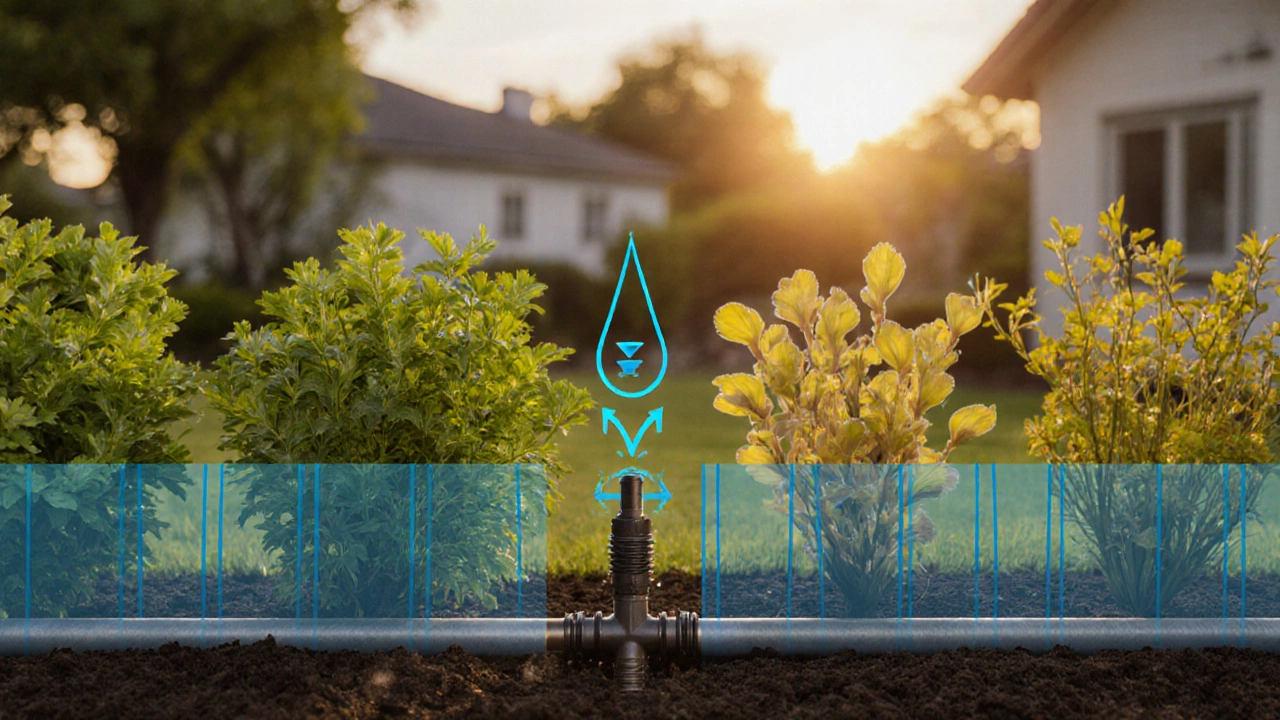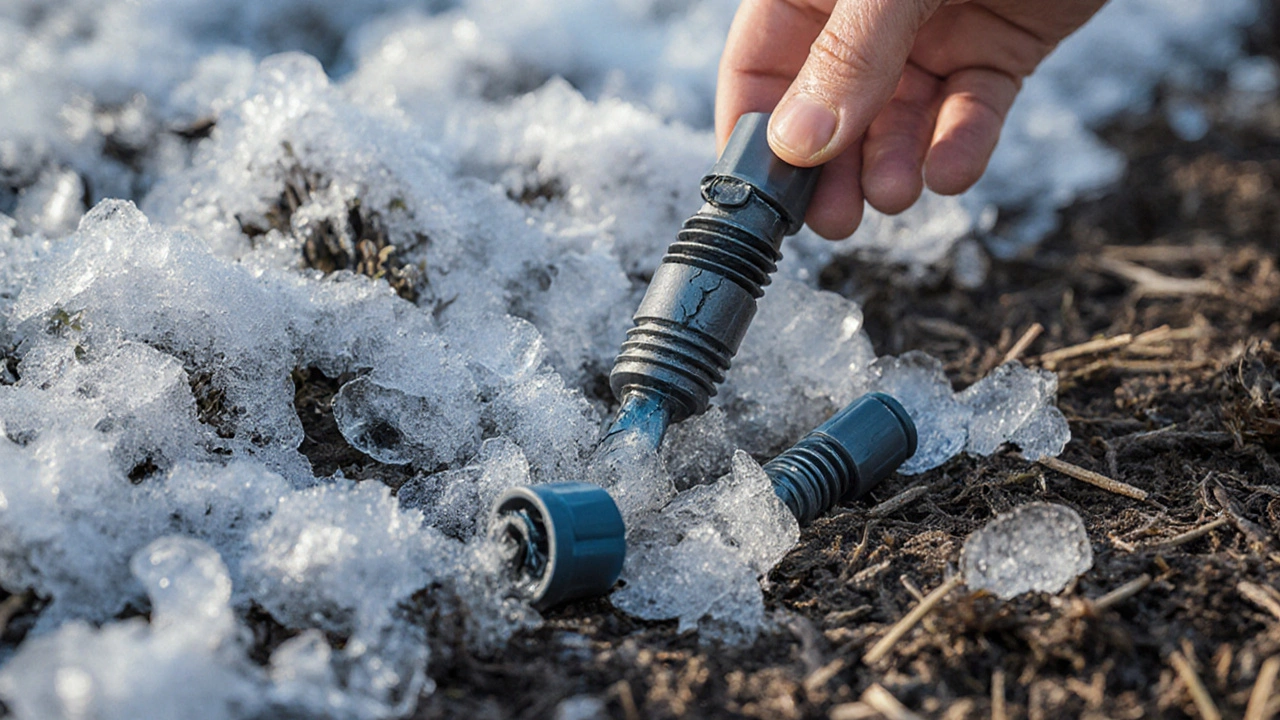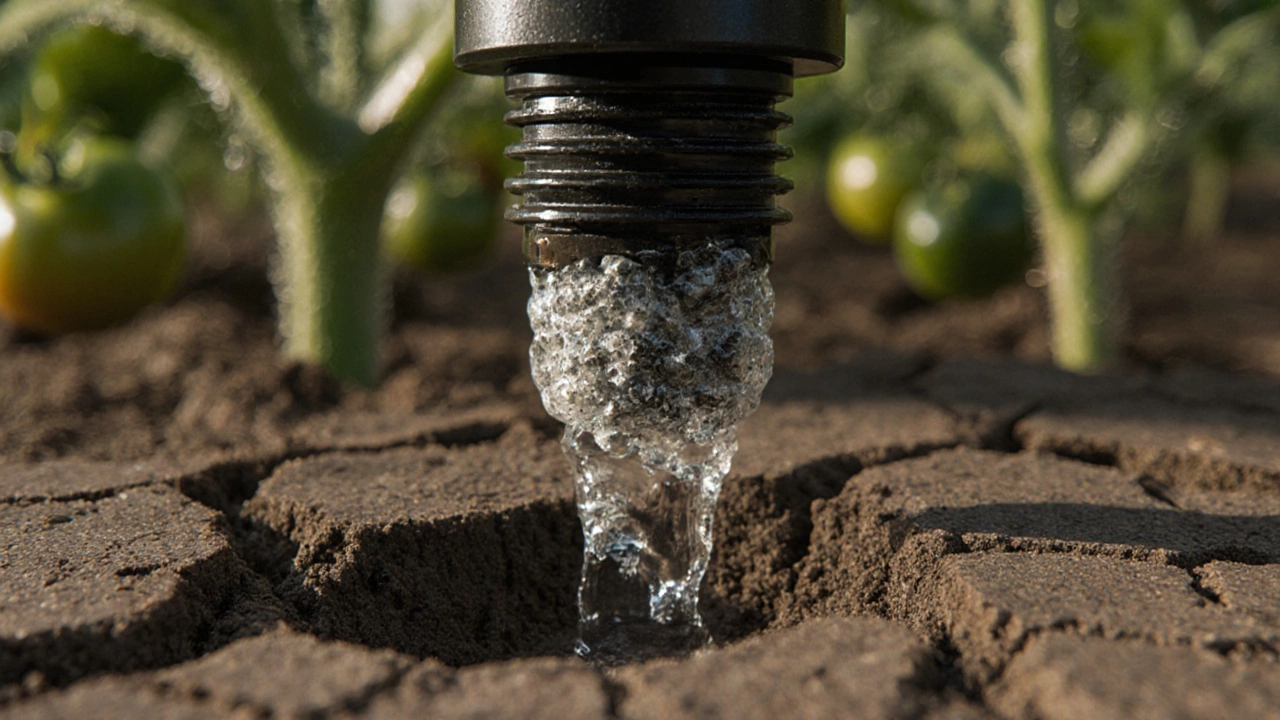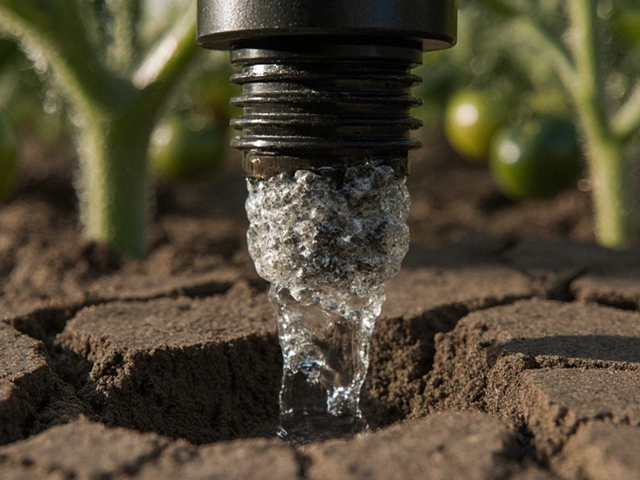Drip Irrigation Water Calculator
Calculate your plants' water needs and determine the right emitter configuration for your drip irrigation system. This tool helps you avoid common issues like clogging, uneven watering, and plant stress.
Plant Water Requirements
Emitter Configuration
Watering Results
Ever set up a drip irrigation system hoping for effortless watering, only to find some plants thriving while others are wilting? You’re not alone. Drip emitters are supposed to deliver water slowly and precisely - but they’re also the most fragile part of the whole system. The problem isn’t that drip emitters don’t work. It’s that they fail in quiet, frustrating ways that most gardeners never notice until it’s too late.
Why Drip Emitters Clog Up So Easily
Drip emitters have tiny openings - often less than 0.5 millimeters wide. That’s smaller than a grain of sand. Water from your tap, well, or rain barrel doesn’t come clean. It carries dust, rust, algae, minerals like calcium and iron, and even tiny bits of organic matter from your water source. Over time, these particles build up inside the emitter, slowly blocking the flow.Hard water areas like Brighton are especially bad for this. If your tap water leaves white residue on your kettle, it’s leaving mineral deposits inside your emitters too. A study by the University of California Agriculture and Natural Resources found that 68% of drip system failures in regions with hard water were due to clogging - not broken pipes or leaks.
And it’s not just minerals. Biofilm - a slimy layer of bacteria and algae - grows inside tubing when water sits still for days. This gunk clings to the inside of emitters and acts like a sponge for more debris. You won’t see it until the water stops flowing. By then, your tomatoes are stressed, your herbs are yellowing, and you’re wondering why your system "just stopped working."
Uneven Watering: The Silent Killer
One emitter might be dripping at 1 gallon per hour. The one next to it? Only 0.2 gallons. That’s not a coincidence. It’s a sign of pressure variation or partial clogging. Drip systems rely on consistent pressure to deliver the right amount of water to each plant. But if your main line is too long, has too many bends, or runs uphill, pressure drops. Emitters farther from the source get less water.And here’s the trap: you think your system is working because some emitters are dripping. You don’t realize half your plants are getting half the water they need. A tomato plant needs about 1.5 gallons per day in peak summer. If it’s only getting 0.6 gallons because of a partially blocked emitter, it’s not just thirsty - it’s going into survival mode. That means fewer fruits, bitter taste, and cracked skins.
Pressure-compensating emitters solve this. They adjust flow rate based on pressure, so each emitter delivers the same amount whether it’s at the start or end of the line. But they cost more - and many gardeners skip them to save money. That’s a false economy. You end up replacing plants, wasting water, and spending hours fixing uneven growth.
Emitters Get Dislodged or Damaged
Drip emitters are often pushed into tubing by hand. They’re not screwed in. That means they can pop out. A dog running through the garden. A rake hitting the line. Even just pulling weeds too close. One tiny tug and the emitter falls out. Water sprays everywhere. You lose control. And you don’t notice until the soil around your basil is soggy while the peppers next to it are dry.Some emitters have locking clips or barbed fittings that hold better. Others just sit loosely. If you’re using cheap emitters from a discount store, they’re probably the kind that fall out easily. Look for emitters labeled "anti-siphon" or "self-locking." They cost a few cents more, but they stay put. And if you’re running lines in high-traffic areas, bury them under 1-2 inches of mulch. That protects them from accidental pulls and UV damage.

Freezing Temperatures Shatter Emitters
If you live where winter dips below freezing, your drip system is at risk. Water expands when it freezes. Even a tiny amount trapped inside an emitter can crack the plastic. You won’t see the damage until spring, when you turn the system back on and find emitters leaking or not working at all.Draining your system before winter helps - but it’s not always enough. Some emitters hold water in their internal chambers even after you shut off the supply. The solution? Use emitters made from flexible, freeze-tolerant materials. Some newer models are designed to expand slightly when ice forms, preventing cracks. Or install manual drain valves at the lowest point of your system. And always remove emitters from tubing if you’re storing the system for winter.
Emitters Age and Degrade
Not all emitters are built the same. Cheap ones made from low-grade polyethylene start to crack after two or three seasons. UV exposure from sunlight turns them brittle. You might not notice until the emitter splits open and sprays water sideways instead of dripping. That’s not just inefficient - it’s a waste. You’re soaking the path instead of the roots.Look for emitters labeled "UV-stabilized" or "outdoor-rated." These are made with additives that slow degradation. Brands like Rain Bird, Netafim, and DIG have tested their emitters for 10+ years of outdoor use. If you’re replacing emitters every year, you’re using the wrong ones. Spend a little more upfront. It pays off in fewer replacements and better plant health.
How to Spot Problems Early
You don’t need a degree in irrigation to catch emitter issues. Here’s what to check every month:- Walk the lines and watch each emitter. Is water dripping steadily? Or just trickling? Or not at all?
- Check for wet patches on the soil where there shouldn’t be any - that means a broken or dislodged emitter.
- Compare plant health. Are some plants thriving while others are stunted? Uneven watering is the likely cause.
- Look at the end of your line. If the last few emitters are weak, pressure drop is the issue.
- Flush the line once a month by opening the end cap for 30 seconds. This pushes out debris before it builds up.
Keep a simple log: note which emitters are slow or dead. That way, you’re not guessing when you need to replace them.

Fixing and Preventing Emitter Problems
The good news? Most emitter issues are easy to fix - if you catch them early.For clogged emitters: Remove the emitter and soak it in a 1:10 solution of white vinegar and water for an hour. Rinse thoroughly. If it’s still blocked, use a pin to gently clear the opening - don’t force it. Replace if it’s cracked or worn.
For uneven flow: Install pressure regulators at the start of each zone. Use pressure-compensating emitters. Keep lines under 100 feet long. If you need longer runs, split into multiple zones.
For dislodged emitters: Switch to self-locking emitters. Use emitter holders or clips to secure them to stakes. Mulch over lines in high-traffic zones.
For freezing: Drain the system before winter. Use freeze-tolerant emitters. Or remove emitters and store them indoors.
For aging emitters: Replace them every 3-5 years, even if they still work. Don’t wait for failure. Buy UV-stabilized models from reputable brands.
What to Buy Instead of Cheap Emitters
Avoid the $5 packs of 100 emitters from big-box stores. They’re a trap. Instead, invest in:- Pressure-compensating emitters - like Netafim Techline or Rain Bird T-Tape
- Self-cleaning emitters - some models have internal filters that flush debris automatically
- UV-resistant tubing - look for 1/2-inch or 3/4-inch tubing rated for 10+ years outdoors
- Inline emitters - built into the tubing, not inserted. Less likely to fall out
Yes, they cost more. But they last longer, use less water, and keep your plants healthy. In the long run, you’ll save money on replacement plants, water bills, and frustration.
Final Thought: Drip Emitters Need Love
Drip irrigation is one of the most efficient ways to water your garden. But it’s not set-and-forget. Emitters are the weak link - and they demand attention. Treat them like your plants: check on them regularly, clean them, replace them before they fail. A few minutes a month can save you hours of troubleshooting and a whole season of lost harvests.Why do my drip emitters clog so quickly?
Drip emitters clog because their tiny openings (often under 0.5mm) trap minerals, dirt, algae, and biofilm from your water source. Hard water areas like Brighton are especially prone to calcium buildup. Regular flushing and using filters can reduce clogging.
How often should I clean or replace drip emitters?
Flush your lines monthly by opening the end cap for 30 seconds. Clean individual emitters with vinegar every 3-6 months. Replace emitters every 3-5 years, even if they still work - UV exposure and wear degrade plastic over time.
Are pressure-compensating emitters worth the extra cost?
Yes. They maintain consistent flow regardless of position in the line, so all plants get equal water - even if your system is long or on a slope. This prevents under-watering and saves you from replacing stressed or dead plants.
Can I use drip emitters in winter?
Only if you drain the system completely before freezing temperatures hit. Water left inside emitters expands when frozen and cracks the plastic. Use freeze-tolerant emitters or remove them for winter storage.
Why are some emitters working and others not?
This usually means pressure drop (if the non-working ones are at the end of the line) or partial clogging (if scattered). Check for debris, ensure you’re using pressure-compensating emitters, and flush the system. Uneven flow is the #1 cause of plant stress in drip systems.


